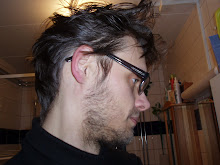Flagg had been reading from this book -- which was bound in human skin -- for a thousand years and had gotten through only a quarter of it. To read too long of this book, written on the high, distant, Plains of Leng by a madman named Alhazred, was to risk madness.
And so, finally, I've once again read my first ever Stephen King novel! It was Christmas Eve in the year of 1988 that I got The Eyes of the Dragon (1987), the hardback's Swedish title the exact translation Drakens ögon. In my childhood and early adolescence I wasn't much of a bookworm, though I was considerably thoughtful and quite. Earlier in the 80s my mother became deeply concerned about my only reading comics like Tomahawk and Phantom, while not being interested in those numerous "children and youth book series" (aside from Olov Svedelid's historical adventures, of which I read a lot, though) she always bought me during the summer holidays.
She then found out that our fourth grade teacher used to read to us children from a book by Lloyd Alexander, the first in the pentalogy, Chronicles of Prydain. Before I had been able to complete the rest of the books about Taran and his many adventures my mother hade gotten hold of a very beautiful, illustrated copy of J.R.R. Tolkien's The Hobbit which I to this very day have kept accessible in my bookcase. After reading about Bilbo I went on to his the Fellowship of the Ring and its trilogy. After this personal endeavor the interest in literature once again faltered; I was not interested anymore with Alexander's work, nor was I able to continue reading Tolkien; The Silmarillion easily took care of that. But then, one white christmas (or was it?), I looked at a dustjacket with an angry, fire breathing dragon printed on it. This how it all began...
The Eyes of the Dragon is not the usual Stephen King novel. It's not about ordinary people in Castle Rock, Maine having to confront the strange nightmares of reality or the supernatural horrors of hauntings, plagues, monsters, vampires and aliens. This is more of a fairy tale, with the characteristics of SKs witty and mature style of writing. The story (dedicated to his then twelve-year-old daughter, Naomi), while not being childish in any way, is not as frightful and dark as some other of his books: It centers on the struggle between good and bad in the land of Delain where the old king Roland is murdered with dragon sand by the hands of his own wizard Flagg (we do know all about HIM, don't we?) who plans to turn the whole kingdom inte ultimate blood and ruin. He frames the would-be king, the older son Peter, for the murder and puts the younger son, Thomas, on the throne as his throne puppet. Now, nobody can stop the ancient magician from fulfilling his plan... However, imprisoned for life 300 feet above ground in The Needle, Peter has a plan to escape -- it includes his childhood doll's house and thousands of royal napikins...
Though I did not find this book quite as inspiring and exciting as the first time, more than 20 years ago, I still thought it worthwile buying it again, reading it in the original language; since I already rediscovered so many King novels, I believed that I should have a try at this one also. The Eyes of the Dragon is not a perfect piece of art, by any standards, but it is a very good tale of fantasy for adolescents and young adults which is both entertaining and intelligent in its creation. What I loved about it, this time around, was the way I recalled the first time meeting all those certain attributes, so typical of Stephen King, that I had learned so much to love. By the way, all those fine sketches by Palladini from the Swedish hardcover edition were also present in the adequate paperback edition I recently read. Very nice, indeed!
Yes, dim -- that was really the best word for it, although others sometimes came to mind: ghostly, transparent, unobtrusive. Invisibility was out of his reach, but by first eating a pizzle [the penis of a bull]and then reciting a number of spells, it was possible to become dim.

